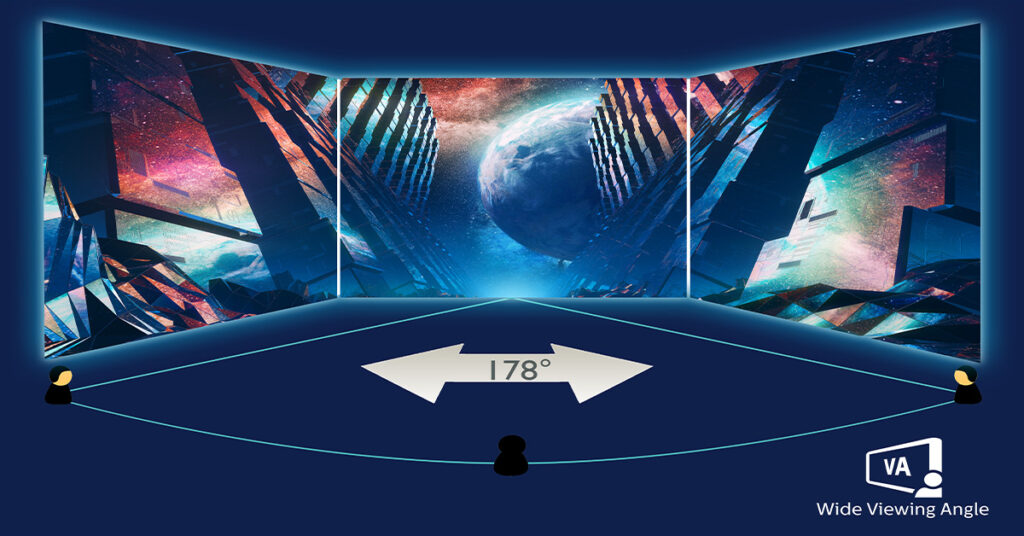VA Panels: What are they good for?

Welcome to the world of panels. As you may already know, there are many monitor panel types to decipher, such as IPS, VA, TN, OLED, and more. In this article, the focus will be solely on VA panels and what their use specifically caters to.
What is a VA Panel?
VA, an acronym for Vertical Alignment, is a common LED display type often used for monitors: It aligns its liquid crystals vertically and runs perpendicular to the glass substrate. When met with voltage, the crystals tilt and let light through, producing color.
However, most importantly, VA panels are well-known for producing deep blacks. With regards to black uniformity, therefore, this panel performs very strongly. In addition, VA panels are also known for producing high brightness levels; thereby producing high contrast ratios that result in vibrant imagery.
Are VA Panel better than OLED?
First and foremost, VA and OLED are two different technologies: While VA panels use a backlight, OLED panels emit their own light. Therefore, comparing the two is not a 100 percent accurate comparison as the two technologies differ fundamentally. OLED offers thinner and more flexible screens, strikingly superior colors, and unlimited contrast.
In addition, while OLED panels have an infinite contrast ratio, VA panels have a finite one. However, apart from comparing the differences, the real question is if VA panels are better than OLED. The answer to this question is: if you are looking for something within a smaller budget, but that can offer great reproduction to enjoy games, movies, and other HDR content, then a monitor with a VA panel is the ideal solution.
Are VA Panel better than IPS?
The answer to whether VA Panels are better than IPS Panels is that it all depends on what the intended use is.
For example, if your goal is to edit photos and videos, or work with CAD, then an IPS panel that offers extreme and precise color accuracy. However, on the other hand, VA panels are particularly appreciated for deeper blacks and a high contrast ratio, which make them great for gaming and entertainment.
Is VA or IPS better for 4k gaming?
When comparing VA and IPS panels, they are much more related than OLED panels. And, although slightly behind in color accuracy, VA panels are great for gaming due to the shadows and details that are often crucial in gaining the upper hand. However, when talking about 4K gaming specifically, IPS panels are used much more commonly paired with such a high resolution. This is due to IPS panels usually offering a fast MRPT rate with little ghosting.
Are VA or IPS panels better for graphic design?
As you may have guessed, color accuracy is fundamental for professions like graphic design and video editing. Due to this, the most common panels used for visually oriented professions are IPS. This, however, does not mean that VA panels are not well-suited for graphic design jobs, but that IPS panels are the preferred option. An example of an IPS monitor with excellent color accuracy is the Philips 27B1U7903: It delivers maximum performance with Thunderbolt ™ 4 and Mini LED backlighting. In addition, the UHD 4K resolution supports 1.07 billion colors and is certified with an HDR value of VESA DisplayHDR™ 1400. With all these visually oriented features in mind, it makes for the ideal choice for graphic design. For more information about the Philips 27B1U7903, please check out the product page here.
Likewise, if you would like to learn more information about IPS panels, feel free to check out our related article here.
4. What is the VA panels best for?
Due to its impressive contrast ratio, VA panels are great for content needing a high HDR classification. This content can range anywhere from movies and TV series, to games. Monitors with VA panels offer a highly detailed and engaging user experience that brings out the deep blacks and bright whites in scenes where you need it most: This is the best feature of VA Panels.
Are VA panels best for gaming?
VA panels are indeed impressive for gaming and you can expect good performance and excellent image quality. To provide an example, the Philips Evnia 27M2C5500W is a curved QHD VA display that is equipped with a rapid 240 Hz refresh rate, which makes it an ideal monitor for gaming. However, whether it is better for gaming or not is not so much of a question of panels as it is other specs. More important specs to look for in gaming are MRPT, Refresh Rate, and HDR certification. As a matter of fact, one of the best refresh rates for gaming is 240Hz, and we have a specific article for this here. For more information about the Philips Evnia 27M2C5500W, please check out the product page here.
Are VA panels good for bright rooms?
VA panels offer a great contrast ratio, which makes them highly versatile. This makes them well-adapted to bright environments as well as low-light scenarios.
In conclusion, VA panels meet your basic needs: whether that be for gaming or viewing high-definition content.
